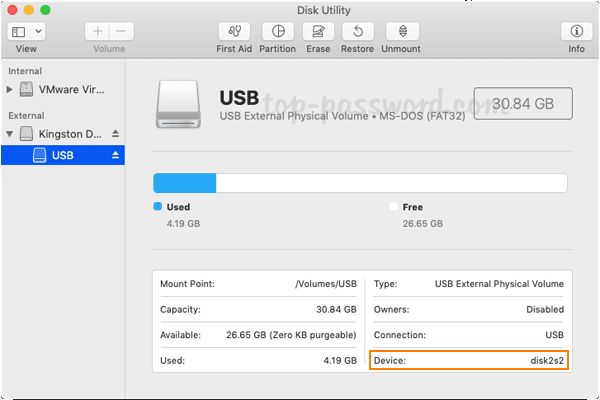How would one go about creating a 10.6.8 bootable USB drive?
- Rufus Create bootable USB drives the easy way Rufus is a utility that helps format and create bootable USB flash drives, such as USB keys/pendrives, memory sticks, etc.
- Insert the USB drive. Open the Disk Utility app. Select the USB drive and click the Erase button. Choose the Name as Untitled, Format as OS X Extended (Journaled) and select Scheme as GUID Partition Map. This option is used for all Intel-based Mac computers.
- The macOS installer file is large with approximate size of 6 to 10GB depending upon the.
- Because since El Capitan the disk utility of macOS was different, if you running El Capitan and want to create bootable U SB for macOS Sierra you can use Yosemite Disk utility for El Capitan just google it! This method also works to creating USB installer for El Capitan, Yosemite and Maverick, and the other previous version of Mac OS X as well.
Connect the USB flash drive to the Mac that you wish to turn into the bootable macOS Big Sur installer, naming the drive 'UNTITLED'. Open the 'Terminal' application via Spotlight by hitting Command + Spacebar and typing Terminal and hitting the return key, through Launchpad, or via the Utilities folder in the Finder. How to download mac os for free.
My job has 20-25 Macbook Pros ranging from 2009-2011 models. The orignal disks are not available for many of these machines. I have a retail 10.6.3 Snow Leopard disk, but this does not work on the newer model Macbook Pros if they need to be reimaged.
Download latest mac operating system.
I would like to image one of the newer Macbook Pros, install all the updates and then create an image that I can use to boot from.
What would be the best solutions to make this happen?
Thank you
MacBook Pro, Mac OS X (10.6.8)
https://reftikesi1977.mystrikingly.com/blog/mac-address-for-amazon-alexa-echo-dot. Posted on
Bootable USB Installers for OS X Mavericks, Yosemite, El Capitan, and Sierra

Create Bootable Usb Mac Disk Utility Windows 7
First, review this introductory article: Create a bootable installer for macOS. Second, see this How To outline for creating a bootable El Capitan installer. Simply replace the Terminal command with the one from the preceding article by copying it into the Terminal window. You will need an 8GB or larger USB flash drive that has been partitioned and formatted for use with OS X.
Drive Partition and Format Anytrans 5 0 0.
- Open Disk Utility in the Utilities' folder.
- After Disk Utility loads select the drive (out-dented entry with the mfg.'s ID and size) from the side list.
- Click on the Erase tab in the Disk Utility toolbar. Name the drive, 'MyVolume'. <---- IMPORTANT!
- In the drop down panel set the partition scheme to GUID. Set the Format type to Mac OS Extended (Journaled.)
- Click on the Apply button and wait for the Done button to activate. When it does click on it.
- Quit Disk Utility.
Create Mac Usb Bootable Drive
Create Installer
Open the Terminal in the Utilities' folder. Choose the appropriate command line (in red) depending upon what OS X installer you want. Paste that entire command line from below at the Terminal's prompt:
Command for macOS High Sierra:
sudo /Applications/Install macOS High Sierra.app/Contents/Resources/createinstallmedia --volume /Volumes/MyVolume --applicationpath /Applications/Install macOS High Sierra.app
Command for macOS Sierra:
sudo /Applications/Install macOS Sierra.app/Contents/Resources/createinstallmedia --volume /Volumes/MyVolume --applicationpath /Applications/Install macOS Sierra.app
Command for El Capitan:

Create Bootable Usb Mac Disk Utility Windows 7
First, review this introductory article: Create a bootable installer for macOS. Second, see this How To outline for creating a bootable El Capitan installer. Simply replace the Terminal command with the one from the preceding article by copying it into the Terminal window. You will need an 8GB or larger USB flash drive that has been partitioned and formatted for use with OS X.
Drive Partition and Format Anytrans 5 0 0.
- Open Disk Utility in the Utilities' folder.
- After Disk Utility loads select the drive (out-dented entry with the mfg.'s ID and size) from the side list.
- Click on the Erase tab in the Disk Utility toolbar. Name the drive, 'MyVolume'. <---- IMPORTANT!
- In the drop down panel set the partition scheme to GUID. Set the Format type to Mac OS Extended (Journaled.)
- Click on the Apply button and wait for the Done button to activate. When it does click on it.
- Quit Disk Utility.
Create Mac Usb Bootable Drive
Create Installer
Open the Terminal in the Utilities' folder. Choose the appropriate command line (in red) depending upon what OS X installer you want. Paste that entire command line from below at the Terminal's prompt:
Command for macOS High Sierra:
sudo /Applications/Install macOS High Sierra.app/Contents/Resources/createinstallmedia --volume /Volumes/MyVolume --applicationpath /Applications/Install macOS High Sierra.app
Command for macOS Sierra:
sudo /Applications/Install macOS Sierra.app/Contents/Resources/createinstallmedia --volume /Volumes/MyVolume --applicationpath /Applications/Install macOS Sierra.app
Command for El Capitan:
sudo /Applications/Install OS X El Capitan.app/Contents/Resources/createinstallmedia --volume /Volumes/MyVolume --applicationpath /Applications/Install OS X El Capitan.app
Command for Yosemite: Free overwatch download pc.
sudo /Applications/Install OS X Yosemite.app/Contents/Resources/createinstallmedia --volume /Volumes/MyVolume --applicationpath /Applications/Install OS X Yosemite.app
Command for Mavericks:
sudo /Applications/Install OS X Mavericks.app/Contents/Resources/createinstallmedia --volume /Volumes/MyVolume --applicationpath /Applications/Install OS X Mavericks.app
Press RETURN. You will be asked for your admin password. It will not echo to the Terminal window. Then press RETURN again. Wait for the return of the Terminal prompt signifying the process has completed. It takes quite some time to finish. Be patient.
Sep 13, 2018 1:16 PM
